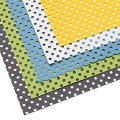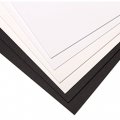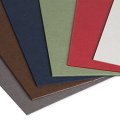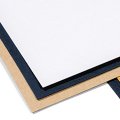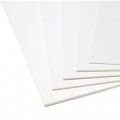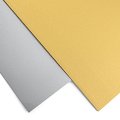Ready-Made Passepartouts
Information about mount board
Passepartout made from wood pulp
By far the largest percentage of passepartouts available today are made from wood pulp. Because this pulp contains residues of lignin and other harmful components, calcium carbonate must be added to the pulp mass during the production process in order to satisfy the pH value requirements. Mounting board that is buffered in this way has a pH value of from 7.5 to 8 and is therefore able to neutralize any acids that may arise as a result of lignin decomposition or atmospheric pollution. Wood pulp passepartouts are normally buffered with about 2 – 3 % calcium carbonate but there are also boards with an admixture of up to 10% that can be found in the marketplace. The more chalk – calcium carbonate is nothing other than that – that they contain, the more difficult it is to work with mounting boards: cutting through chalk is much more difficult for the passepartout blade than just cutting through cellulose fibre. And the calcium carbonate harbours yet another disadvantage: bromide silver photographs (a coating that has almost completely fallen out of use) or gelatine coated photographs should not be mounted on buffered boards because the buffering will damage them.
Our premium passepartouts contain about 2 – 3% calcium carbonate and have a pH of about 7.7. During the process of aging, this value will decline but will still remain at a safe level for a long time:
pH when new is 7.7; pH at 20 years is 7.6; pH at 50 years is 7.5; pH at 100 years is 7.3.
We offer these high quality premium passepartouts in a large number of different coloured surfaces as well as cores. The colour of the core is in no way an indication of the acidity of a mounting board – a pure white passepartout can have the same pH value as a dyed one. The back side of the passepartouts are abrasion resistant.
